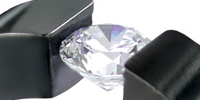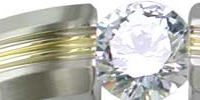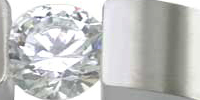Titanium Engagement Rings
How To Choose An Engagement Ring, Part 1Choosing the right engagement ring can be a confusing process. This page is designed to help you make educated decisions on what type of engagement ring will be best for your situation.There are three main decisions you will need to make when selecting your engagement ring:
Step 1: Choosing An Engagement Ring DiamondBefore you can select an engagement ring diamond, you will need to have a basic understanding of the
diamond grading system.
Generally, diamonds are graded according to the "4 Cs" - Cut, Clarity, Color, and Carat. For more information on what these terms mean,
look at all about the diamond grading system. The most important thing when specifying the diamond(s)
for your engagement ring is to select a diamond with the highest rating in all 4 categories for your budget. For instance, it would not make
much sense to sacrifice the cut, clarity, and color just to get a slightly larger carat size. So try to balance the "4 Cs" when shopping for
an engagement ring and make sure to ask your jeweler about the specific grade of the diamonds they are offering. The tables below provide a basic
explanation of Cut, Clarity, Color, and Carat.
What is a Carat?Carat is the unit of weight used to describe a diamond. A carat is equivalent to 0.20 grams and can be subdivided into 100 points (0.01 carat = l point). Since larger diamonds are found less frequently, the value per carat increases with carat size. If you are interested in the technical details, wikipedia has a couple of great articles on diamond clarity and diamond color. Continue to Step 2... |
   A titanium engagement ring signifies the lasting strength and beauty of your commitment to each other. |
|||||||||||||||||||||||||||||||||||||||||||||||||||||||||||


